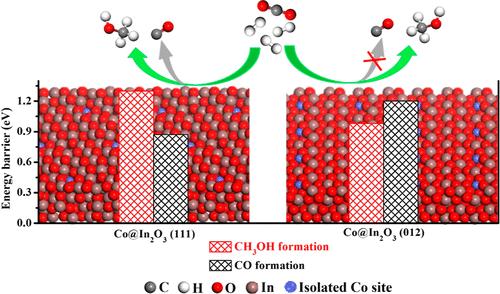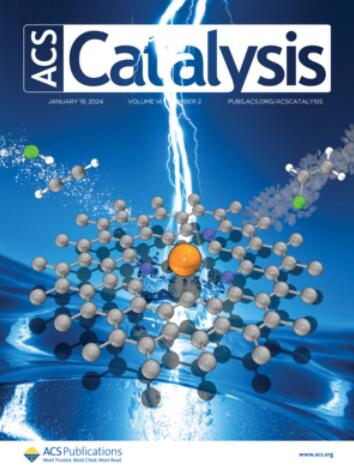Structure Sensitivity of an Atomic Co-Promoted In2O3 Catalyst toward CO2 Hydrogenation to Methanol
IF 11.3
1区 化学
Q1 CHEMISTRY, PHYSICAL
引用次数: 0
Abstract
Deciphering the relationship between the active site structure and the CO2 hydrogenation to methanol mechanism over In2O3-supported high-dispersed metal catalysts faces great challenges. Herein, by using atomically dispersed Co@In2O3 with the main exposed facet as a model catalyst, Co@In2O3 (111) and Co@In2O3 (012) are prepared to investigate the structure sensitivity toward CO2 hydrogenation. Co@In2O3 (012) exhibits higher methanol selectivity (78.0%) with a prominent durability within a 100 h time-on-stream test at 280 °C and 9000 mL g–1 h–1, while Co@In2O3 (111) exhibits a mediocre selectivity of methanol (64.7%) but relatively higher CO2 conversion. Experiments and theoretical simulations substantiate that the hydrogenation of CO2 to methanol follows the formate pathway over both catalysts. The oxygen vacancy sites on the Co@In2O3 (012) surface can more effectively stabilize the intermediates of the CO2 hydrogenation reaction and exhibit a lower reaction energy barrier of the rate-determining step about the conversion of HCOO* to H2COO*, achieving a higher methanol selectivity. This study might be of great aid in providing comprehensive insight into the structure–activity relationship of Co@In2O3 catalysts and the design of robust catalysts for highly selective hydrogenation of CO2 to methanol.

求助全文
约1分钟内获得全文
求助全文
来源期刊

ACS Catalysis
CHEMISTRY, PHYSICAL-
CiteScore
20.80
自引率
6.20%
发文量
1253
审稿时长
1.5 months
期刊介绍:
ACS Catalysis is an esteemed journal that publishes original research in the fields of heterogeneous catalysis, molecular catalysis, and biocatalysis. It offers broad coverage across diverse areas such as life sciences, organometallics and synthesis, photochemistry and electrochemistry, drug discovery and synthesis, materials science, environmental protection, polymer discovery and synthesis, and energy and fuels.
The scope of the journal is to showcase innovative work in various aspects of catalysis. This includes new reactions and novel synthetic approaches utilizing known catalysts, the discovery or modification of new catalysts, elucidation of catalytic mechanisms through cutting-edge investigations, practical enhancements of existing processes, as well as conceptual advances in the field. Contributions to ACS Catalysis can encompass both experimental and theoretical research focused on catalytic molecules, macromolecules, and materials that exhibit catalytic turnover.
 求助内容:
求助内容: 应助结果提醒方式:
应助结果提醒方式:


